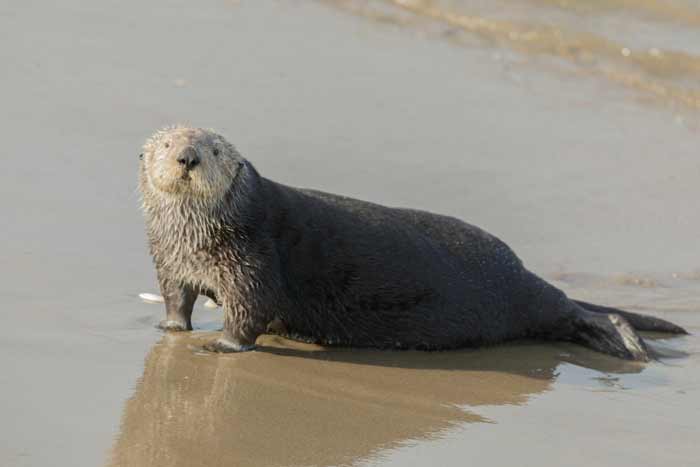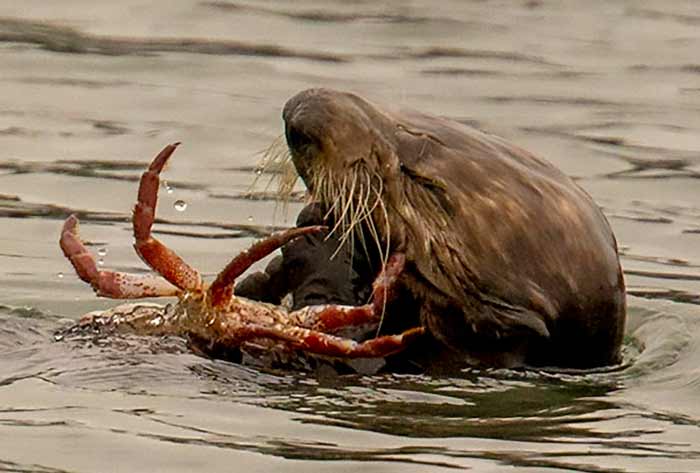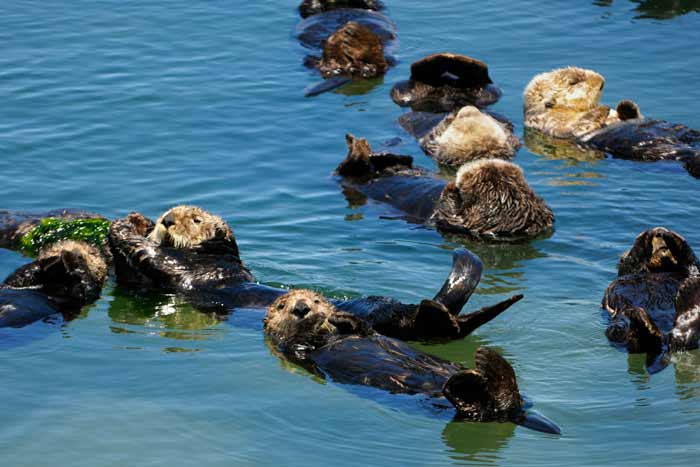Otters, with their playful nature and aquatic skills, are fascinating creatures. However, the sea otter and river otter are distinct species with notable differences.
This article explores these differences in detail, highlighting key aspects such as habitat, physical characteristics, diet, and behavior.
Quick Overview
| Sea Otter | River Otter | |
|---|---|---|
| Size | Length: 3-5 feet Weight: 20-80 pounds | Length: 3-4 feet Weight: 15-20 pounds |
| Body Shape | Robust and rounded, short tail, large webbed feet | Elongated and agile, long tapering tail |
| Fur | Densest of any mammal, provides insulation | Sleek, dense fur, aids in swift movement |
| Diet | Sea urchins, clams, crabs, seaweed | Fish, frogs, crayfish, birds, reptiles |
| Lifespan | 12-15 years | 9-12 years |
| Habitat | Coastal regions of the North Pacific Ocean | Freshwater rivers, streams, lakes, and wetlands |
| Social Behavior | Forms large groups (rafts), strong community bonds | More solitary or small family groups, territorial |
| Unique Behaviors | Uses tools to open shellfish, holds hands while sleeping | Playful, often seen sliding down riverbanks |
Physical Characteristics

The physical differences between these two species are quite pronounced. Sea Otters are the heavier of the two, with adults typically reaching lengths of 3-5 feet and weighing between 20-80 pounds.
Their bodies are robust and rounded, with a distinctive short tail and large, webbed back feet ideal for swimming. Their fur, the densest of any mammal, provides vital insulation in the cold ocean waters.

River Otters, on the other hand, are sleeker and more streamlined. They typically measure 3-4 feet in length and weigh around 15-20 pounds. Their bodies are elongated and agile, with a long, tapering tail and sleek, dense fur that aids in their swift movement both in water and on land.
Habitat and Distribution
Sea Otters are quintessential marine mammals, predominantly inhabiting the coastal regions of the northern and eastern North Pacific Ocean. Their entire lifestyle is intricately tied to the ocean, where they perform almost all of their daily activities, including eating, sleeping, and even grooming.
Unlike many marine mammals, sea otters rarely come ashore, preferring the buoyant comfort of the ocean’s surface, often amidst kelp forests that provide them with food and protection.
River Otters, in stark contrast, are more versatile in their habitat preferences. They thrive in a variety of freshwater environments such as rivers, streams, lakes, and wetlands. River otters are also comfortable in coastal marine environments, showcasing their adaptability.
Known for their playful and curious nature, river otters are often spotted engaging in what appears to be recreational activities like sliding down muddy or snowy riverbanks, a behavior that is as practical for travel as it is enjoyable.
Diet and Lifespan

Dietary habits of these otters also reflect their environmental adaptations. Sea Otters have a specialized diet consisting mainly of sea urchins, clams, crabs, and seaweed. They are known for their remarkable use of rocks as tools to crack open shellfish.
Sea otters play a crucial ecological role, particularly in maintaining the health of kelp forests. They typically live for 12-15 years in the wild.
River Otters exhibit a more varied diet, feeding on fish, frogs, crayfish, birds, and reptiles. Their diet is indicative of their opportunistic hunting style and adaptability to different environments.
River otters, with their playful hunting techniques, contribute significantly to the balance of their freshwater habitats. They have a slightly shorter lifespan than sea otters, living about 9-12 years.
Social Behaviors and Mating

Socially, Sea Otters are known for their strong community bonds. They often form groups, known as rafts, which can consist of hundreds of individuals. These rafts play a crucial role in their survival, offering protection and aiding in the rearing of young.
Sea otters are also known for their endearing behavior of holding hands while sleeping to prevent drifting apart.

In contrast, River Otters tend to be more solitary or live in smaller family groups. They are less likely to form the large social groups seen in sea otters.
River otters are territorial, especially the males, and their social interactions are often more about establishing and defending territories than forming long-term social bonds.
Conclusion
In conclusion, sea otters and river otters, though similar in appearance and playful demeanor, exhibit a fascinating array of differences that reflect their specialized adaptations to marine and freshwater environments, respectively.
From their physical characteristics and dietary preferences to their social behaviors and habitats, these differences underscore the incredible diversity of life and the importance of each species in maintaining the ecological balance of their respective environments.
Understanding and appreciating these nuances not only deepens our connection with the natural world but also highlights the importance of conserving these remarkable creatures and their habitats.
FAQs
Sea Otters are larger, primarily marine animals with dense fur, found in the North Pacific Ocean. River Otters are smaller, more agile, and inhabit freshwater rivers, streams, and lakes.
While River Otters can adapt to coastal marine environments, Sea Otters are strictly marine and do not inhabit freshwater environments like River Otters.
Sea Otters primarily feed on sea urchins, clams, crabs, and seaweed, while River Otters have a varied diet including fish, frogs, crayfish, birds, and reptiles.
Sea Otters are known for forming large groups called rafts and exhibit strong community bonds. River Otters, in contrast, are more solitary or live in smaller family groups.
Yes, Sea Otters are generally larger, measuring 3-5 feet in length and weighing 20-80 pounds, compared to River Otters, which are about 3-4 feet long and weigh 15-20 pounds.
Sea Otters typically live for 12-15 years, while River Otters have a slightly shorter lifespan of 9-12 years.
No, the use of tools to open shellfish is a unique behavior observed in Sea Otters and is not seen in River Otters.




